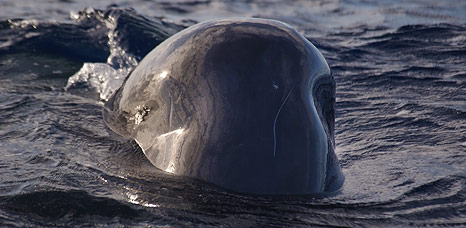Tour leader Ed Drewitt describes unforgettable encounters with some of the oceans' giants, including a spyhopping female Sperm Whale right next to the boat, during our 'Whales & Dolphins of the Azores' holiday last week ...
Sperm Whale spyhopping (Ed Drewitt)
The unpredictability of the sea gives it a magical lure - you just don’t know what you’ll see next. Certainly, our trip to the Azores this week kept everyone on their toes with some exciting surprises.
The deep underwater canyons provide ideal feeding places for Sperm Whales which dive down to 3km, and with an absence of any predators such as Orcas, it’s a brilliant place for them to spend with calving and feeding young. Therefore, we weren’t disappointed on our six boat trips out to sea off the coast of the island of Pico – watching the antics of up to seven or eight different Sperm Whales, mostly adult females and many with young including some only a few weeks old. We observed the animals logging on the surface, re-oxygenating their blood ready for another deep dive. And finally, as they were ready to go, a characteristic dip of the of back meant the memorable tail fluke moment was inevitable – as the animal sank underwater, its tail was stuck up in the air like a flag being waved before the start of a race.
The baby Sperm Whales were often peduncle feeding – dipping under water for a minute or two to receive a squirt of milk from their mother before returning to the surface for air. One very young whale was keeping up with its mother as she shallow-dived, swimming along and rising out of the surface like an athlete swimmer at full pace.
The icing on the cake came on our fourth trip out – despite the choppy seas, we were the only boat that went out looking for whales. We were rewarded by a young adult female who came to investigate us – we were just as much being watched by the whale as we were watching her! She came within a metre of the boat, doing a full circuit and spyhopping, poking her head above the water’s surface, as she did. We could see even the smallest scratches on her skin and occasionally as she rose out of the water we could see her lower jaw, discretely forming the lower part of her head. She turned over so we could see her paler belly and, when changing direction, she swept her tail fluke up sideways. This continued for 15 minutes or more before she decided we were safe and swam away to relax on the surface for a while before deep diving!
During our trips we also saw Common and Bottlenose Dolphins and were very much entertained by their antics. While the Common Dolphins were fast and energetic the Bottlenose Dolphins were slower and more refined in their movements, often appearing in small groups riding the waves before submerging deep below to feed.
The unpredictable nature of the sea generated some extra Naturetrek gems.
On our last trip we ventured further away from our normal haunts, to see what else may be out there. In glassy, smooth water we suddenly spotted the characteristic emergence of a whale or dolphin. We had extraordinary close views, as at least six of these animals revealed themselves as Sowerby’s Beaked Whales – we could see their long beaks and even the scratches on their green-grey coloured skin. They quickly disappeared, although during the rest of the trip we kept having glimpses of other individuals coming up to breathe.
We also encountered the notorious Portuguese Man O’War jellyfish which we frequently spotted floating across the open ocean. Not a jelly fish at all, but an amalgamation of small creatures called Zooids which take on different roles – some become the long tentacles while others form the sausage-shaped balloon-like float.
Mobula Rays, huge rug-like fish, floated close to the sea’s surface while Pilot Fish sheltered below floating debris. Some, such as crates revealed a few Grey Triggerfish. One floating piece of plastic in the shape of a banner was home to a Columbus Crab – a tiny animal which began life in the Sargasso Sea before leading a nomadic life on floating debris, feeding on the larvae of other creatures such as Goose Barnacles which also live on such mobile homes.
The birdlife was also rich and full of surprises. Alongside the many Cory’s Shearwaters, rafting flocks revealed Great Shearwaters – on their journey south to breed on islands in the southern oceans. We spotted a Manx Shearwater, a more familiar species here in the UK, and had more distant views of Little or Macaronesian Shearwaters. Meanwhile, a passing skua revealed itself as a Long-tailed Skua in its summer splendour. On land, Canaries, and the Azorean subspecies of Blackbird, Chaffinch, Goldcrest and Woodpigeon were also present. On the last day we caught up with some endemics to the Azores, the Azorean Noctule Bat and the Azorean Grayling Butterfly. We were out one evening, too, listening for the characteristic gurgling calls of displaying male Cory’s Shearwaters and spotted many flying overhead as their white underparts were caught in our torch light.
Six days, two whale and two dolphin species later, plus a plethora of other marine and land-based wildlife and plants left everyone with a renewed sense of awe, excitement and urge to experience more – indeed some clients decided to go swimming with dolphins and fulfil a life-long ambition. We left the Azores with some very memorable moments etched on our minds – and no doubt perhaps the Sperm Whale that came so close to our boat has us in her memory too!
To read more about our 'Whales & Dolphins of the Azores' holiday, click here.



 Loading search...
Loading search...
